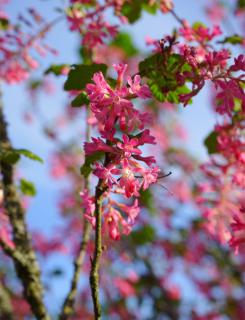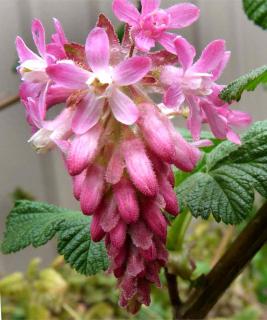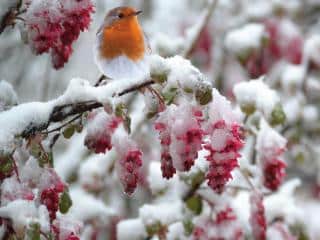

Flowering currant bears magnificent blooms in spring.
Key Flowering currant facts
Name – Ribes sanguineum
Family – Grossulariaceae
Type – shrub
Height – 3 to 10 feet (1 to 3 m)
Exposure – full sun
Soil: ordinary – Foliage: deciduous – Flowering: mid→end spring
Easy to care for, planting and pruning will help you boost its growth and bear beautiful flowers.
Favor planting in fall or in spring but avoid freezing temperatures or high temperatures.
In a hedge, space each plant at least 30 inches (80 cm) apart.
 It is very easy to propagate flowering currant through cuttings at the end of winter.
It is very easy to propagate flowering currant through cuttings at the end of winter.
Water abundantly during the first year to make sure it settles in well.
Occasionally, you might notice seeds sprouting from fallen seeds. Transplant them to a pot to plant elsewhere or give away to friends!
Like most flowering shrubs, pruning serves to increase foliage density and enhance flowering year after year.
For the first year, only light pruning is needed that will guide the shrub into producing more stems.
No need to prune drastically, the flowering currant might suffer from it.
 This is a regular pruning that can be repeated yearly, that increases the blooming and the growth of the shrub.
This is a regular pruning that can be repeated yearly, that increases the blooming and the growth of the shrub.
Finally, to recover a tightly-bound silhouette and avoid it growing sparse at the foot, you can prune drastically after a couple years.
Even though it is quite hardy, flowering currant does nonetheless fall victim to certain diseases and parasites such as powdery mildew and aphids.
 Hardy to the cold and freezing, it can cope with temperatures dropping down to 5°F (-15°C).
Hardy to the cold and freezing, it can cope with temperatures dropping down to 5°F (-15°C).
This shrub has the advantage of flowering abundantly in bunches, and this creates a true “wall of flowers” when planted as a hedge.
But it is also liked just as much when standing isolated in the garden, in shrub beds and even in pots or garden boxes on a terrace or balcony.
It is hardy and grows fast, which makes it an easy shrub to grow that will reward you with quick results.
A white-flowered variety also stands out:
Read also:
If it grows too large or to renew its vigor, proceed to prune drastically every 4 to 5 years!
Just a note to let you know that my flowering currant is blooming nicely! It’s the one you suggested that I prune back more than I might usually do. It looks so nice, and another one is blooming, also. I have 3 seedlings but they won’t bloom this year. Probably my favorite shrub!
I think I will try the cuttings. Thanks so much!
I have four flowering currants, and love them. Loaded with blossoms except for my newest one, planted last Spring. My oldest plant did not bloom as heavily this year or last. I plan to prune like you have suggested. Thanks for the advice.
Sure thing! Happy to have been of service. Take a few cuttings from what you prune, too. Though it isn’t the season (after the blooming isn’t best for cuttings), a portion of them might make it. You can grow them in pots at the beginning and gift them to friends and neighbors!